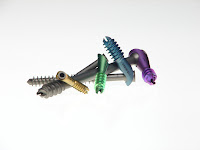
Yesterday I finally had an opportunity to give the Extremity Medial IoFix implant a try. The patient had a history of osteoporotic bone (as noted in her previous hallux abducto valgus correction) therefore, I sought out a new implant that could help manage the frailness of the bone. And as expected, I was not disappointed.
As with most new implants and instrumentation, putting the first post and screw in took a few extra minutes. However, with this device, the learning curve was quick and the second construct was inserted in a noticeably faster application. One caveat that I can pass along is that I accidentally overdrilled past the laser-etched mark (on the drill) prior to inserting the second post. The over drill is very sharp and in this case when combined with soft bone caused the post to fit loosely within the bone. Although this error on my part was negated with the final screw purchase, pre-drilling for the post prior to screw insertion should not be overlooked.

Overall, the construct was very solid and I was impressed by the way it essentially neutralized the porosity of the patient's poor bone quality. A few of the tips that are demonstrated in this technique video were utilized during the case and really helped me with screw placement. This prevented contact between the two interfragmental screws. The next time that you are preparing for an arthrodesis procedure, consider looking into the Extremity Medical IoFix Implant. If you are concerned about wall breakout or osteoporotic bone, using this implant is a no-brainer.
All Extremity Medical products are viewable here at www.FootandAnkleFixation.com
The Unbiased Authority: There are no conflicts of interest or financial association/assistance between FootandAnkleFixation.com and Extremity Medical






Great video showing the steps for this unique intraosseous fixation device.
ReplyDeleteOne caveat- Extremity Medical recommends placing the initial guide wire for the X-Post 5-10mm from the joint line (not 14mm). This ensures that all the threads of the lag screw clear the joint and allows for optimal compression.
Mike Cerame
Extremity Medical
Product Manager